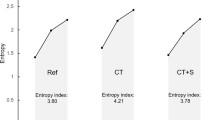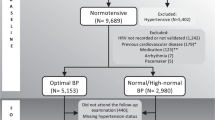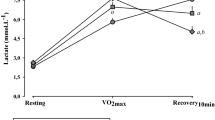Abstract
Disturbed sympathetic and also parasympathetic activity of the autonomic nervous system points to pathological alterations in the cardiovascular system. Untreated hypertensive subjects were examined with respect to the question of whether an increase in sympathetic activity necessarily goes along with a reduction in parasympathetic activity, and whether ‘delayed’ recovery behaviour after mental stress could be an indicator of a disturbed cardiovascular function. In 20 male hypertensive (HT) and 20 normotensive (NT) subjects (control group), heart rate variability (HRV) was compared during rest and under mental stress. The testing procedure consisted of the following phases: habituation, arithmetic tasks without and with interference, recovery. HRV was analysed using the trigonometric regressive spectral analysis (TRS). Proceeding from the total variance (ms2), the weighted averaged frequency (Hz) and the variance parts (ms2) in the frequency bands ‘low frequency’ (LF-band: 0.04–0.15 Hz) and ‘high frequency’ (HF-band: 0.15–0.40 Hz) were explored. The variance part modulated by spontaneous breathing within the HF-band was assessed additionally. The variance part in the LF-band under mental stress was significantly increased in the HT group (P<0.01). Activity in the HF-band (without the respiration-dependent part) under mental stress did not differ between both groups, whereas the breathing-modulated part of variance in the HF-band was reduced in the HT subjects. During the recovery period in the HT group, the weighted averaged frequency was still elevated compared to baseline, and the variance part in the LF-band was increased, which may point to delayed recovery behaviour. In addition, by using a discriminant analysis 85% of all subjects were reclassified to the original groups, all HT subjects being assigned ‘correctly’. Spectral variance parameters enable early discovery of altered cardiovascular regulation. Respiration influences variance in the HF-band in hypertensive subjects and should therefore be paid attention to. The variance part in the LF-band, weighted averaged frequency and the respiration-modulated variance in the HF-band turned out to be the most valid parameters for the differentiation between NT and HT subjects.
This is a preview of subscription content, access via your institution
Access options
Subscribe to this journal
Receive 12 digital issues and online access to articles
$119.00 per year
only $9.92 per issue
Buy this article
- Purchase on Springer Link
- Instant access to full article PDF
Prices may be subject to local taxes which are calculated during checkout




Similar content being viewed by others
References
Stimpel M . Arterielle Hypertonie. In: De Gruyter W (ed). Pschyrembel Klinisches Wörterbuch. Walter de Gruyter: Berlin, New York, 1998, p 721.
Covic A, Goldsmith DJA, Covic M . Reduced blood pressure diurnal variability as a risk factor for progressive left ventricular dilatation in hemodialysis patients. Am J Kidney Dis 2000; 35: 617–623.
Kikuya M et al. Prognostic significance of blood pressure and heart rate variabilities: the Ohasama study. Hypertension 2000; 36: 901–906.
Berntson GG et al. Heart rate variability: origins, methods and interpretive caveats. Psychophysiology 1997; 34: 623–648.
Malliani A, Pagani M, Lombardi F, Cerutti S . Cardiovascular neural regulation explored in the frequency domain. Circulation 1991; 84: 482–492.
Parati G, Saul JP, Di Rienzo M, Manchia G . Spectral analysis of blood pressure and heart rate variability in evaluating cardiovascular regulation: a critical appraisal. Hypertension 1995; 25: 1276–1286.
Parati G et al. The analysis of blood pressure and heart rate variability: methodological aspects and interpretation of results. High Blood Pressure 1995; 4: 186–203.
Malik M, Camm AJ . Components of heart rate variability—what they really mean and what we really measure. Am J Cardiol 1993; 72: 821–822.
Pagani M et al. Power spectral analysis of heart rate and arterial pressure variabilities as a marker of sympathovagal interaction in man conscious dog. Circ Res 1986; 59: 178–193.
Hayano J et al. Accuracy of assessment of cardiac vagal tone by heart rate variability in normal subjects. Am Cardiol 1991; 67: 199–204.
Langewitz W, Rüddel H, Schächinger H . Reduced parasympathetic cardiac control in patients with hypertension at rest and under mental stress. Am Heart J 1994; 127: 122–128.
Pagani M et al. Sympathovagal interaction during mental stress. Circulation 1991; 83 (Suppl 2): SII43–SII51.
Pichot V et al. Wavelet transform to quantify heart rate variability and to assess its instantaneous changes. J Appl Physiol 1999; 86: 1081–1091.
De Boer RW, Karemaker JM . Spectrum of a series of point events, generated by the integral pulse frequency modulation model. Med Biol Eng Comput 1985; 23: 138–142.
Cowan MJ et al. Comparison of autoregression and fast Fourier transform techniques for power spectral analysis of heart period variability of persons with sudden cardiac arrest before and after therapy to increase heart period variability. J Electrocardiol 1992; 25 (Suppl): 234–239.
Wagner T, Rudolf M, Noack F . Die Herzfrequenzvariabilität in der arbeitspsychologischen Feldforschung — Methodenprobleme und Anwendungsbeispiele. Z Arbeits- Organisationspsychol 1998; 42: 197–204.
Ruediger H, Klinghammer HL, Scheuch K . The trigonometric regressive spectral analysis a method for mapping of beat-to-beat recorded cardiovascular parameters on to frequency domain in comparison with Fourier transformation. Comput Methods Programs Biomed 1999; 58: 1–15.
Stark R, Schienle A, Walter B, Vaitl D . Effects of paced respiration on heart period and heart period variability. Psychophysiology 2000; 37: 302–309.
Porges SW, Byrne EA . Research methods for measurement of heart rate and respiration. Biol Psychol 1992; 34: 91–130.
Seibt R, Naumann H-J . Blutdruckselbstmessung und 24-h Blutdruckmessung verbessert die Diagnosefindung der Hypertonie. Therapiewoche 1995; 26: 1545–1550.
Seibt R, Naumann H-J, Hinz A . Bewertungskriterien der Blutdruckselbst-messung und der 24-Stunden-Blutdruckmessung. Nieren- Hochdruck- krankh 1996; 81: 337–340.
Pickering TG . Blood pressure measurement and detection of hypertension. Lancet 1994; 344: 31–35.
Schrader J . Prognostische Bedeutung der 24-Stunden Langzeitblutdruck-messung. Nieren- Hochdruckkrankh 1995; 24: 640–644.
Staessen JA . Ambulatory blood pressure monitoring in clinical trials. Nieren- Hochdruckkrankh 1999; 28: 461–464.
Parati G et al. Clinical relevance of blood pressure variability. J Hypertens 1998; 16 (Suppl 3): 25–33.
WHO/ISH-Guidelines-Subcommittee. World Health Organization-International Society of Hypertension; Guidelines for the Management of Hypertension. J Hypertens 1999; 17: 151–183.
Ashida T et al. Relationship between home blood pressure measurement and medication compliance and name recognition of antihypertensive drugs. Hypertens Res 2000; 23: 21–24.
Deutsche Hochdruckliga. Leitlinien für die Prävention, Erkennung, Diagnostik und Therapie der arteriellen Hypertonie. Dtsch Med Wochenschr 2001; 126: S201–S238.
Asmar R, Zanchetti A, and the Participants of the First International Consensus Conference on Self-Blood Pressure Measurement: Guidelines for the use of self-blood pressure measurement. A summary report of the first inter national consensus. J Hypertens 2000; 18: 493–508.
Düker H, Lienert A . Konzentrations-Leistungs-Test. In: Hogrefe CJ (ed). Handanweisung. Verlag für Psychologie: Göttingen, 1965, pp 1–16.
Task Force of the European Society of Cardiology and The North American Society of Pacing and Electrophysiology. Heart rate variability Standards of measurement, physiological interpretation, and clinical use. Circulation 1996; 93: 1043–1065.
Ruediger H, Bald M . Spontaneous baroreflex sensitivity in children and young adults calculated in the time and frequency domain. Auton Neurosci 2001; 93: 71–78.
Laude D et al. Comparison of various techniques used to estimate spontaneous baroreflex sensitivity—The EuroBaVar study. Am J Physiol Regul Integr Comp Physiol 2004; 286: R226–R231.
Kamphuis A, Frowein HW . Assessment of mental effort by means of heart rate spectral analysis. In: Orlebeke JF, Mulder G and van Doormen LPJ (eds). The psychophysiology of Cardiovascular Control. Plenum Press: New York, 1985, pp 841–853.
Mulder LJM et al. Respiratory pattern, invested effort, and variability in heart rate and blood pressure during the performance of mental tasks. In: Di Rienzo M, Mancia G, Parati G, Pedotti A, Zanchetti A (eds). Computer Analysis of Cardiovascular Signals. IOS Press: Amsterdam, 1995, pp 219–233.
Eckberg DL . Sympathovagal balance: a critical appraisal. Circulation 1997; 96: 3224–3232.
Huikuri HV et al. Heart rate variability in systemic hypertension. Am J Physiol 1996; 77: 1073–1077.
Esperer HD . Die Herzfrequenzvariabilität, ein neuer Parameter für die nicht- invasive Risikostratifizierung nach Myokardinfarkt und arrhythmogener Synkope. Herzschr Elektrophys 1992; 3: 1–16.
Author information
Authors and Affiliations
Corresponding author
Rights and permissions
About this article
Cite this article
Ruediger, H., Seibt, R., Scheuch, K. et al. Sympathetic and parasympathetic activation in heart rate variability in male hypertensive patients under mental stress. J Hum Hypertens 18, 307–315 (2004). https://doi.org/10.1038/sj.jhh.1001671
Received:
Revised:
Accepted:
Published:
Issue Date:
DOI: https://doi.org/10.1038/sj.jhh.1001671
Keywords
This article is cited by
-
Effect of the menstrual cycle on circulation during combined spinal-epidural anaesthesia
BMC Anesthesiology (2018)
-
Trigonometric regressive spectral analysis: an innovative tool for evaluating the autonomic nervous system
Journal of Neural Transmission (2013)
-
Acute autonomic effects of vitamins and fats in male smokers
European Journal of Clinical Nutrition (2009)
-
A novel autonomic activation measurement method for stress monitoring: non-contact measurement of heart rate variability using a compact microwave radar
Medical & Biological Engineering & Computing (2008)
-
Untersuchung zur Genauigkeit der Abtastung von EKG-Signalen für eine nachfolgende Spektralanalyse kontinuierlich gemessener RR-Intervalle im Schlaflabor
Somnologie - Schlafforschung und Schlafmedizin (2006)



